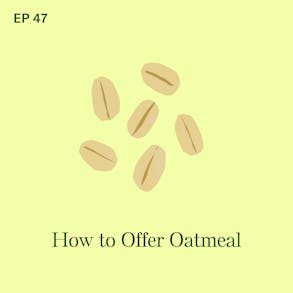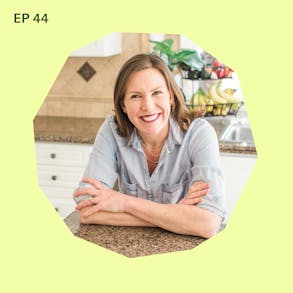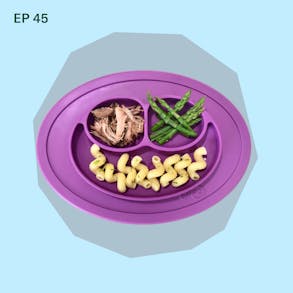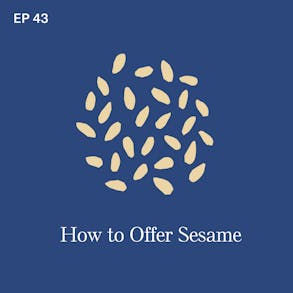Top 5 BLW Questions Answered
In this episode we're talking about:
- Is it safe for babies to try 1 new food each day or do I really have to wait 3-5 days between new foods?
- What do I do if my baby breaks off a big bite or a smaller piece of food in their hand…do I need to intervene?
- HELP! My baby has no interested in food - we just started solid foods and my baby won't touch or eat the food!
- What if I want to switch from purees and do more of a baby-led weaning approach: is it too late to switch from purees to BLW?
- Which foods can babies safely eat and how do you prep those foods?

LISTEN TO THIS EPISODE
Episode Description
What’s YOUR biggest burning baby-led weaning question?! Wondering about gagging vs. choking, what to do if your baby breaks off a big bite in their mouth, switching from purees or how to handle allergic reactions? In this episode I’m answering 5 of the most asked baby-led weaning questions from all of 2022.
Links from this Episode
- Baby-Led Weaning with Katie Ferraro program with the 100 First Foods™ Daily Meal Plan, join here: https://babyledweaning.co/program
- Baby-Led Weaning for Beginners free online workshop with 100 First Foods™ list to all attendees, register here: https://babyledweaning.co/baby-led-weaning-for-beginners
Other episodes related to this topic:
- Episode 84 - Why You DON'T Need to Wait 3-5 Days Between New Foods with Carina Venter, PhD, RD https://blwpodcast.com/episodes/84

Latest Episodes






Katie Ferraro (31s):
And so parents who ask like, gosh, I thought I had to wait three to five days between new foods. That's what my doctor says. That's based on a fear of having an allergic reaction to food. But it's important to know that if your baby's going to have an allergic reaction to food, the vast majority of those allergic reactions are going to occur within minutes and up to no more than two hours following ingestion. So it's not like you feed your baby a food and then three days later there's a weird diaper and you're like, oh my gosh, they're allergic to it. It doesn't work like that. We definitely don't need to wait three to five days between introducing new foods. You wanna go much, much faster to help your baby achieve diet diversity. Hey there. I'm Katie Ferraro, registered dietician, college nutrition professor and mom of seven specializing in baby-led weaning here on the baby-led weening Made Easy podcast I help you strip out all of the noise and nonsense about feeding, leaving you with the confidence and knowledge you need to give your baby a safe start to solid foods using baby-led weening.
Katie Ferraro (1m 28s):
Hey guys, welcome back. Today I'm sharing answers to the five most frequently asked questions about baby-led weaning. Now I'm recording this episode close to the end of 2022 for release in early 2023, and at the end of the year we always go through our stats from the past year, including the most frequently asked BLW questions from my free weekly video workshop that's called Baby- led weaning for a beginner. So at the end of this hour long video training, I do a q and a and then answer parent and caregiver questions so we make a point to respond to every question. If we don't get to it on the workshop, then Caitlin or dietician or myself, we follow up to each of these questions by email. So I feel like we have like a really good pulse on the types of questions that parents are asking, and it's so fun to see them fluctuate.
Katie Ferraro (2m 13s):
Like kind of depending upon, you know, what's like going crazy on TikTok. Parents will ask certain questions about certain foods or if they see other articles in the news and they'll be like, Hey, is this true? But if you took a look at the entire year, what I wanted to do was just boil it down and share with you the five most frequently asked questions from the baby-led weaning for beginner's workshop. And if you haven't taken the workshop yet, it's a one hour video training where I walk you through what the first few days of baby-led weaning look like, show you how to introduce all of the allergenic foods, talk about getting over your fear of gagging. And I give everyone on that workshop a copy of my hundred first foods list. You can sign up for this week's workshop times by going to baby-led weaning dot co and stick around to the end of the workshop where you can ask any leftover, burning, baby-led weaning questions that you have.
Katie Ferraro (2m 56s):
So with no further ado, here's the top five questions from all of 2022 about baby-led weaning. Number one, is it safe to try one new food each day? And, that question's usually followed up with like, how do you observe for an allergic reaction if you're doing a new food all the time? Well, here's the answer to that. Yes, it's definitely safe to try one or more than one new food every day. Sometimes parents will say, wait, I thought I need to wait three to five days between foods. That's what my doctor said. And no, you do not need to wait three to five days between foods. We've done a lot of different episodes on this topic. If you go back to episode 84, it's all about why you don't need to wait three to five days between new foods. I interviewed leading food allergy expert and PhD pediatric dietician, Carina Venter on that topic.
Katie Ferraro (3m 37s):
But basically the notion there is that parents are scared to introduce foods like quickly because they think if there's an allergic reaction, they won't know which food caused a reaction. Here's the deal. If your baby is going to have an allergic reaction to food, the vast majority of allergic reactions will occur within minutes and up to no more than two hours following ingestion. So it's not like you feed your baby pork and three days later there's a weird diaper. No, oh my gosh, they're allergic to pork, which by the way, your baby's not gonna be allergic to pork. That was a bad example. But the point is, the allergenic foods I do build in a three day pad. So in my program, when we're introducing five new foods for a week, we start by doing the first allergenic food in week one Friday. We do it two times on Friday, two times on Saturday, two times on Sunday. So we're doing six or seven different exposures of that same allergenic food over the course of the weekend with no other new foods in there cuz you wanna be able to observe for any potential reactions, but you can continue to include all the previous familiar foods from other days, the low risk non-allergenic foods along with those new allergenic foods.
Katie Ferraro (4m 30s):
But yes, it's definitely safe to do one or more than one new food per day. I don't do two new allergenic foods in the same day though, because of course, if the baby did have a reaction to one of the big nine allergenic foods, those are the nine foods that account for about 90% of food allergy in the United States. If there was a reaction, you wanna make sure you know which food caused the potential reaction, but other than that, don't wait three to five days between foods you guys that unnecessarily slows your baby down. All right, second question. What if my baby breaks off a big bite or breaks off a piece of food? Will they choke? Okay, and this is usually after parents have learned as they teach on the workshop that the safest size for baby-led weaning foods are foods that are about the size of your adult pinky finger. And that's so that the baby who doesn't have their pincer grip yet, right?
Katie Ferraro (5m 12s):
Because early on those early eaters at six and seven, eight months of age, your baby doesn't have their pincer grasp. So they're gonna use their whole hand or their pincer grasp to rake or scoop the foods up and into their mouth. We make the foods longer so that they can actually pick the food up and bring it to their mouth. But yes, of course they're going to break off a piece of the food in their mouth. That's the point. That's the precursor to chewing is breaking that food off and getting it into a more manageable size that the baby can then maneuver and manipulate around their mouth. So the intention is to have the baby being the one, bringing the food to their mouth, squeezing the piece off either in their hand or in their mouth or with their gums or with their tongue. And at the beginning they'll move it around, spit it out. Sometimes they swallow a little bit of it, but as long as the baby is the one driving the eating experience, then that Is baby-led weaning in motion.
Katie Ferraro (5m 58s):
We don't wanna be cutting up foods into little tiny pieces. I was at a restaurant the other day with a family member and she was cutting up her food super duper small because she was so scared that her baby was going to choke. And I was saying, gosh, you know, it's actually the opposite, right? The bigger pieces of food are safer early on in baby-led weaning. We wanna stay away from the super tiny size pieces, but if the baby is the one who breaks that food off into a smaller size, we need to trust that the baby will know what to do with that in their mouth and they're going to learn what to do with it in their mouth. But they don't need us to intervene. They need us to offer longer pieces of food about the size of our adult pinky finger early on in self-feeding. Hey, we're gonna take a quick break, but I'll be right back.
Katie Ferraro (7m 30s):
Third question that we get a lot is help. My baby has no interest in food. It's like we just started solid foods, we've done a couple of meals, my baby just sits there, he won't touch it. You guys, this question totally typical for babies in the first few days and weeks of baby-led weaning, there is not very much action slash eating occurring early on in baby-led weaning. That's typical. Babies need lots of time to learn how to eat. And the good thing is, is you've got this like insurance policy in place called Infant milk. So breast milk or formula that's still providing the majority of baby's nutrition needs as you start solid foods. So it's totally okay if they're not eating a lot early on. So I would encourage you to offer solid foods one to two times per day when your baby is six to seven months of age.
Katie Ferraro (8m 13s):
And sometimes parents would be like, but they're doing absolutely nothing. And I know it feels counterintuitive and counterproductive, but double up on the amount of practice and the number of times your baby is eating a day if they're doing absolutely nothing because practice makes progress. And we can sit there with our babies, offer those foods, sit across from them, be very exaggerated in how we bring the foods to our mouth and demonstrate how we chew foods and swallow foods. But honestly, if your baby's not getting a lot of practice at the table with foods, then they're not going to be making very much progress. But please understand that very early on, not a whole lot happens, but sometimes things as little as touching the food or picking a piece up or even putting it in their ear or their hair. Remember learning how to eat is a full sensory experience.
Katie Ferraro (8m 54s):
And so those are all, all actually parts of learning how to eat, even though it might not look like eating to you, but hang in there, it will happen with practice. All right, fourth most common question we get is about switching from purees. Usually along the lines of like, I started with purees and now I wanna switch to baby-led weaning. My baby hates being spoon-fed, we're only doing purees and my too late to switch to baby-led weaning. No, you are not too late to make the transition from purees. Purees are actually a very important texture for your baby to master. It's just not the only texture of food that your baby can eat. So in my programs I teach a purees for a few days approach to starting solid foods, and that's where we do purees from a preloaded spoon for the first two, sometimes three days in addition to solid strips of food.
Katie Ferraro (9m 36s):
Okay? So we do a thin puree of that food, a chunkier puree of that food, and then soft solid strips of that food all in the same 15 or 20 minute feeding on day one. And then when we move to day two and we're trying a new vegetable, we do a thin puree from a preloaded spoon, a chunkier puree from a preloaded spoon. The baby usually picks it up by hand, but then also the soft strips of that vegetable on day two. And then by day three with a lot of the grains, sometimes they're in pureed form, we can do it from a preloaded spoon, but when I get to day four and we do that first meat, we don't need to puree those foods anymore. Okay? You don't even have to puree foods if you don't want to. And if you've been doing purees and putting the spoon in your baby's mouth, if you want to adopt more of a baby-led approach, you've got to start doing that pre-loaded spoon approach.
Katie Ferraro (10m 18s):
I could teach you all about how to do that and show you what it looks like inside of that baby-led weaning for beginner's workshop. If you're kind of more of a visual person, you can sign up at baby-led weaning dot co to take that one hour video training where I walk you through the first few days, show you what the purees for a few days approach looks like, but know you're not too late to make the switch. But we do know that that flavor window where babies will like and accept a wide variety of foods and flavors and tastes and textures, that window's not open forever, okay? And we want to take advantage of that in infancy. And our goal is to have most of your baby's nutrition coming from food. By the time your baby turns one and purees are not going to get you there. So if you've been doing purees, it is time to make the leap to try out some more finger foods.
Katie Ferraro (10m 57s):
Then it might also help you to know that research shows us that it's the babies who've had the least amount of experience with finger foods that are actually at elevated risk of choking. So even if you're scared to push past purees, you've got to do this because it's developmentally appropriate for your baby and what they need as far as next steps to start learning how to eat more real food so that by age one most of their nutrition is coming from food and not from Infant milk anymore. Hey, we're gonna take a quick break, but I'll be right back.
Katie Ferraro (12m 34s):
All right? Fifth most common question we get is around which foods can my baby safely eat? It'll be like, can my baby eat mushroom? Can my baby eat pork? Can my baby eat asparagus? Insert the name of the foods. And the answer is yes. Babies can eat almost all foods early on in self-feeding. Now, certainly there's foods that we don't feed our baby. I have a whole list of 15 FOODS NEVER TO FEED YOUR BABY, though these are foods we wanna stay away from. This is a free feeding guide that I put together cuz I like to focus on all the foods your baby can eat. But I do think it's important to point out the foods that are a choking hazard or for other reasons we should not be offering to baby. They're all about safety. And so those 15 FOODS NEVER TO FEED YOUR BABY, that's in a free feeding guide that you can download. If you check the show notes where you're listening to this podcast, you can get that free feeding guide called 15 FOODS NEVER TO FEED YOUR BABY.
Katie Ferraro (13m 20s):
But I want you to look at all the other foods out there and be like, Hmm, yes, my baby can safely eat these foods. And one thing that we've made a point of doing on our team from the last two years is demonstrating in the first week of Baby-led weaning all 100 foods from the hundred First Foods list. And I'm proud to say that as of the end of 2022, we finished the last one. It was Duck. Duck was the one food left on the hundred first foods list that I had never done in week one of baby-led weaning with a baby. I just did it with this adorable baby, baby Florence. And I kind of checked off my own version of the hundred First Foods list that over the past two years I have featured a baby in video on Instagram or YouTube or TikTok showing all hundred of the foods in the first week of baby-led wing, just to show you guys that there's no right or wrong foods to start with, And, that we can modify and make almost all foods safe for early eaters to learn how to eat.
Katie Ferraro (14m 10s):
So again, if you wanna grab a copy of that hundred first Foods list and work your way through all the hundred foods on that list, that hundred first foods list I gave away to everyone for free on that baby-led weaning four BEGINNERS workshop, head to baby-led weaning dot co to sign up for this week's workshop times. You can also grab all of the links that I mentioned in today's episode on the show notes page for this episode, which is at BLW podcast.com/ 296. And a special thank to our partners at AirWave Media. If you guys like podcasts that feature food and science and using your brain, check out AirWave Media for some great other podcast opportunities. And we are on the web. Our baby-led weaning podcast homepage is at BLWpodcast.com.
Katie Ferraro (14m 53s):
And again, BLWpodcast.com/296 will take you to where you need to be for the links for this episode, including that free feeding guide, 15 FOODS NEVER TO FEED YOUR BABY, and where you can sign up to take the baby-led weaning for beginner's video workshop and get your own copy of the hundred first foods list. And at the end of that workshop, that's when I do the Q and A session. So if you've been learning about baby-led weaning or listening to the podcast and you still have questions about giving your baby a safe start to solid foods, drop 'em in the question box at the end of that workshop and I'd love to answer your question for you. Thanks so much for listening. I'll see you guys next time.

The Program Baby-Led Weaning with Katie Ferraro
A step-by-step digital program for starting solid foods safely and navigating the original 100 FIRST FOODS™ meal plan with baby-led weaning.
 EXPERT-LED, PROVEN APPROACH TO EATING REAL FOOD
EXPERT-LED, PROVEN APPROACH TO EATING REAL FOOD CONCISE VIDEO TRAININGS TO MASTER BABY-LED WEANING
CONCISE VIDEO TRAININGS TO MASTER BABY-LED WEANING 100 FIRST FOODS DAILY MEAL PLAN WITH FOOD PREP VIDEOS
100 FIRST FOODS DAILY MEAL PLAN WITH FOOD PREP VIDEOS
Baby-Led Weaning for Beginners Free Workshop
Is your baby ready to start solid foods, but you’re not sure where to start? Get ready to give your baby a solid foundation to a lifetime of loving real food…even if you’re feeling overwhelmed or confused about this next stage of infant feeding.
Get baby-led weaning recipes and tips delivered to your email inbox.

